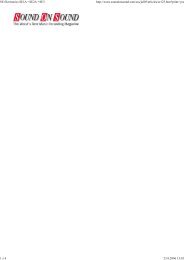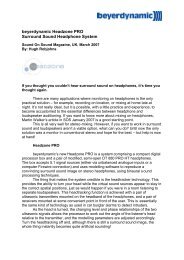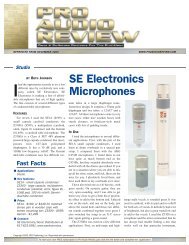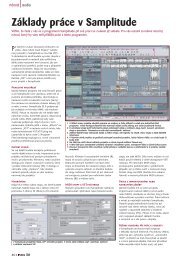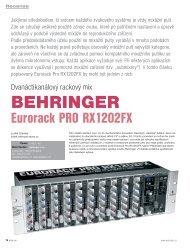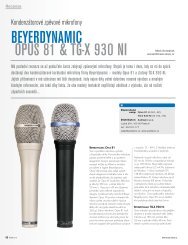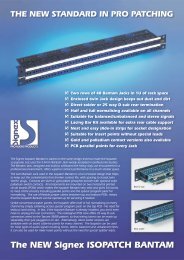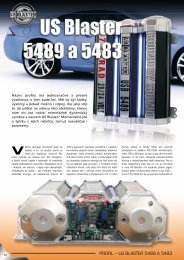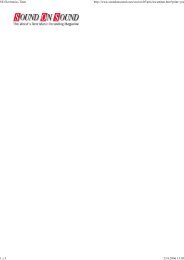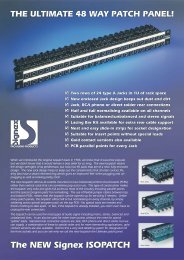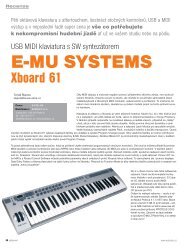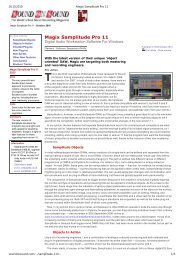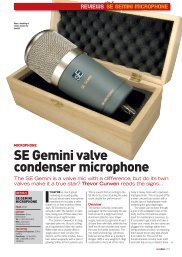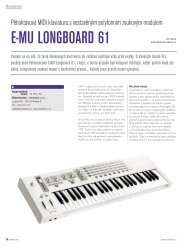You also want an ePaper? Increase the reach of your titles
YUMPU automatically turns print PDFs into web optimized ePapers that Google loves.
REPRINTED FROM APRIL 2007<br />
<strong>Trident</strong> <strong>8T</strong> <strong>16</strong>-<strong>Channel</strong><br />
<strong>Analog</strong> <strong>Console</strong><br />
Versatile, great-sounding small format mixer<br />
with a distinct <strong>Trident</strong> pedigree.<br />
APPLICATIONS<br />
Studio, porject studio<br />
KEY FEATURES<br />
<strong>16</strong> channels; eight-track busses;<br />
three-band EQ; eight aux sends;<br />
<strong>16</strong> direct outs; optional meter bridge<br />
PRICE<br />
$3,498<br />
CONTACT<br />
<strong>Trident</strong> Audio Ltd. |<br />
☎ +44 1474 815 300<br />
➲ www.tridentaudio.co.uk<br />
ith all the advances in digital<br />
consoles and direct-to-computer<br />
recording these days, its<br />
refreshing to see companies,<br />
such as John Oram’s <strong>Trident</strong><br />
Audio Ltd. willing to make<br />
high-quality analog boards<br />
with traditional routing options. Many engineers<br />
love the sound and straightforward, linear<br />
approach of an analog board for recording<br />
to analog or digital sources.<br />
The <strong>Trident</strong> <strong>8T</strong>, priced at $3,498 for <strong>16</strong>-<br />
channels, is a classic example of a great sounding,<br />
relatively inexpensive analog board, still<br />
made in the UK — and it offers incredible<br />
flexibility. Yeah, it it does not use discrete components<br />
in the audio path,<br />
like the original<br />
<strong>Trident</strong> Series<br />
80, but this<br />
by John Gatski<br />
op-ampbased<br />
board has<br />
serious enough sonic<br />
quality to showcase the<br />
increased dynamic range and detail<br />
subtleties of 24-bit/96-kHz recording.<br />
| FEATURES<br />
The <strong>Trident</strong> <strong>8T</strong> is based on the original<br />
<strong>Trident</strong> Series 80 design, especially the EQ section.<br />
The consoles configuration range from<br />
eight to 32-channels. The <strong>8T</strong> is packed with<br />
plenty of features including eight aux sends,<br />
monitor buss, mono selection, optional meter<br />
bridge ($1,050). Each channel also has peak<br />
and signal-present LEDs for those working<br />
without the meter bridge.<br />
The console features such goodies as balanced<br />
direct outputs for each of the channels<br />
(<strong>16</strong> in the test unit’s case), eight track busses,<br />
eight aux sends and the same high quality mic<br />
preamps as the S20 standalone pre, which<br />
PAR tested and recommended highly. The<br />
entire console input and output structure is<br />
balanced. The microphone inputs are XLR<br />
while the rest of the I/Os are 1/4-inch TRS.<br />
WWW.PROAUDIOREVIEW.COM<br />
As mentioned, the EQ section is based on the<br />
original <strong>Trident</strong> Series 80 EQ, to which <strong>Trident</strong><br />
Audio, Ltd. owner Mr. John Oram contributed<br />
circuitry and sonic design back in the 1970s. The<br />
three-band EQ includes: high-shelf filter, highmid<br />
level control, low-mid level control, and<br />
low-shelf control. The high-shelf turnover frequency<br />
is switchable to either 8 kHz or 12 kHz.<br />
The high-mid frequency control is<br />
adjustable from 1 kHz to<br />
15 kHz. The<br />
low-mid<br />
frequency control<br />
ranges from<br />
100 Hz to 1.5 kHz. The<br />
EQ section also includes 50 kHz low-cut filter;<br />
the low-shelf frequency can be set to either 60<br />
Hz or 120 Hz.<br />
This console has plenty of I/Os including<br />
the eight track busses, three sets of stereo outputs<br />
(L/R, main and closefield), as well as the<br />
array of aux send/returns The board also has<br />
a talkback output and mic input for talkback.<br />
Each channel has balanced, quarter-inch<br />
connections for line, tape, aux send/return<br />
(TRS), and the direct channel output. The balanced<br />
XLR input connects the microphone to<br />
the preamp and can also be used as a balanced<br />
XLR line input with the “unity” switch<br />
engaged. The insert jack on each channel uses<br />
the common TRS unbalanced send/return<br />
scheme (also in the original Series 80).<br />
Copyright 2007 JRS Publishing (USA), Inc. Reprinted with permission.
There are a few interesting channel features<br />
not traditionally found on consoles in this<br />
price range including a “flip” switch, which<br />
swaps the tape inputs (on the rotary faders)<br />
with the live inputs (on the faders), allowing<br />
quick reconfiguration between recording and<br />
mixing modes.<br />
For the money, the <strong>Trident</strong> <strong>8T</strong> has a great<br />
subgroup section with the eight track (a.k.a.<br />
submix) busses. In addition to the L/R buss,<br />
each track can be assigned to any of the 4 track<br />
buss pairs; panning is used to isolate the signal<br />
to odd or even numbered busses of the<br />
pairs.. Each track buss has its own master output<br />
and buss solo button. An additional button<br />
on each pair allows discrete stereo soloing<br />
of each pair (as opposed to the traditional<br />
PRODUCTPOINTS<br />
• Sonics<br />
• Pleanty of I/Os<br />
• Eight track busses<br />
• Quality build<br />
• Same meter bridge components as<br />
high-end <strong>Trident</strong>s<br />
• Wiggly rotary pots<br />
• Needs more meter bridge backlighting<br />
• Where’s the manual?<br />
SCORE<br />
Incredibly versatile, great-sounding analog board for the<br />
serious professional home or recording studio<br />
mono solo function).<br />
Metering is done via two classic, ovalshaped,<br />
blue, backlit onboard VU meters,<br />
which can monitor the track busses, the main<br />
output bus, and two track returns. The meters<br />
are set at 0 VU at +4 dBu, with a -10 dB attenuator<br />
switch designed to match with highlevel<br />
digital signals. In addition to the aforementioned<br />
EQ and buss-assign controls, each<br />
channel also features a solo engage button and<br />
a flexible aux buss section that gives a maximum<br />
of options using a minimum of space.<br />
The first two of three aux send level knobs are<br />
switchable between auxes 1 & 3 and 2 & 4<br />
respectively. The third level knob is a stereo<br />
send that is switchable between aux pairs 5/6<br />
or 7/8 and can be configured pre- or postfader.<br />
The <strong>8T</strong> is equipped with smooth, tight<br />
100-mm faders for the channels and the main<br />
stereo output. Output controls are available<br />
for monitor section, track busses, solo, talk<br />
back section and headphone amp.<br />
The <strong>8T</strong> board boast great specs including<br />
ultra-low noise from input to output and a 45<br />
kHz (- 3 dB point) frequency response to<br />
ensure a accurate top end past 20 kHz, which<br />
is good for those high resolution recordings.<br />
Other specs include 0.008-percent distortion.<br />
The board is attractive looking; its wood<br />
trim and optional meter bridge give it a classy<br />
pedigree — even in a modest home studio<br />
decor. And with the power supply outboard<br />
and rack mountable, the <strong>8T</strong> fits into quite a<br />
compact footprint. The <strong>16</strong>-channel version, as<br />
tested, is only 29-inches wide and weighs a<br />
mere 40 pounds, making it ideal for tightspaced<br />
pro home studios and live remote<br />
recording gigs.<br />
According to a U.S. <strong>Trident</strong> dealer, most of<br />
the <strong>8T</strong>s have been sold into home studios in<br />
the U.S.<br />
| IN USE<br />
The <strong>Trident</strong> was easy to set up and use,<br />
which was a good thing since a proper manual<br />
was still in production. Subsequently, most<br />
of this review’s specs and control features<br />
were taken off the <strong>Trident</strong> web site.<br />
I recorded a bunch of acoustic guitar/vocal<br />
tracks mixed straight to two-channel high resolution<br />
PCM. Using several microphones,<br />
including my trusty Audix SCX-25s, a pair of<br />
Heil PR-40s and Shure KSM 32s. I routed the<br />
main outputs of the <strong>Trident</strong> to the Benchmark<br />
ADC-1 converter, set at 24-bit/96 kHz, which<br />
then fed either an Alesis Masterlink or TAS-<br />
CAM DV-RA1000.<br />
When recording to the two-track recorder<br />
via the stereo mix busses, I not only routed<br />
audio to the main recorder at 96 kHz from the<br />
main stereo buss, but I simultaneously fed a<br />
second digital recorder running at 44.1 kHz<br />
from one of the other stereo outputs. This<br />
enabled me to make CD sample rate compatible<br />
references of the same recording without<br />
later having to sample rate convert from the<br />
reference 96 kHz. The <strong>8T</strong> is a great board for<br />
feeding different sources. I also tracked to the<br />
recorder via the direct outputs and the track<br />
busses.<br />
So how does it sound? The stereo bus output<br />
tracks that were recorded with the Audix<br />
SCX-25s on Martin and Guild acoustic guitars,<br />
plus voice and a electric Gibson L5 jazz guitar,<br />
recorded with Shure KSM-32s, were all very<br />
good to excellent sounding. From the stereo<br />
buss, the 96 kHz stereo recordings were very<br />
accurate and clean with a touch of that analog<br />
warmth but not so warm that the dynamics<br />
and transients were lost. Stereo imaging was<br />
quite good as well.<br />
The direct channel outputs, as expected,<br />
produced the most transparent recording with<br />
slightly more transient energy and less warmness,<br />
but the summing buss acquitted itself<br />
quite well.<br />
As a testament to good design, this board<br />
is really quiet, with nary any hiss — even with<br />
the controls cranked way up. It is super clean<br />
with plenty of headroom.<br />
On the pair of Heil PR-40 microphones, a<br />
great dynamic with extended bottom end<br />
response, I used the EQ to add some top end<br />
and air to a Martin D35, and the EQ delivered<br />
audibly pleasing results with out adding<br />
harshness. Just what you want in an EQ.<br />
The control and fader integrity is quite good<br />
— especially the faders. The “Fleximount”<br />
rotary controls are a bit wiggly feeling, but not<br />
noisy and very linear. The push-button switches<br />
engage okay, but the plastic buttons can fall<br />
can fall off when transporting the board [The<br />
company assures this has been addressed. — Ed.].<br />
Although the board can be used with its<br />
dual VUs, I believe those who do a lot of<br />
tracks are going to want the optional meter<br />
bridge. It contains so much more level information<br />
about multiple inputs and outputs<br />
versus the VUs. However, the meter bridge<br />
does make it more difficult to plug into some<br />
of the connections. The headphone jack and<br />
direct outputs, for example, were a bit of tight<br />
reach since they are the furthest in.<br />
Also, the meter bridge legend illumination<br />
is too dim to easily read the reference level<br />
numbers. I think it could use a little bit more<br />
backlighting.<br />
| SUMMARY<br />
The <strong>Trident</strong> <strong>8T</strong> is a quality, pure analog<br />
console that bridges the gap between the lowbuck<br />
utility recording mixer and the high-end,<br />
without much compromise in audio quality of<br />
the latter. Its logical, easy-to use layout and<br />
plethora of I/Os and adept monitoring and<br />
routing flexibility make it well suited for all<br />
kinds of recording tasks: studio, live recording,<br />
etc. Clearly a best buy console in my book.<br />
| EQUIPMENT SETUP<br />
Audix SCX-25 microphones, Heil PR-40<br />
dynamic microphones, Shure KSM-32 microphones,<br />
TASCAM DV-RA1000, Alesis<br />
Masterlink, Benchmark ADC-1 24-bit/192<br />
kHz converter, Westlake Interconnects,<br />
Esoteric DV-50 Universal DVD-A/SACD player<br />
John Gatski is the publisher/executive of Pro<br />
Audio Reivew.<br />
Copyright 2007 JRS Publishing (USA), Inc. Reprinted with permission.<br />
Reprinted from Pro Audio Review



